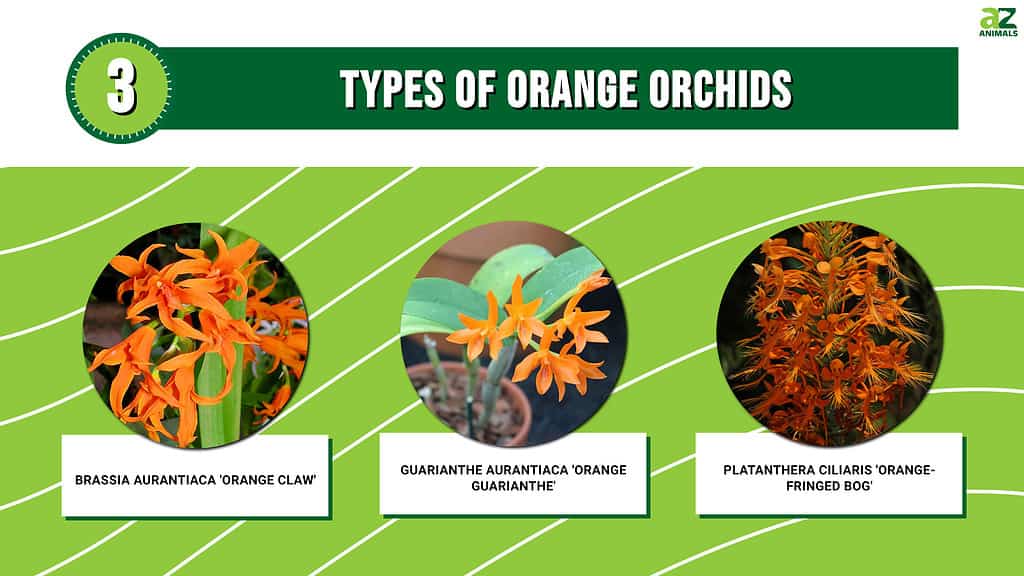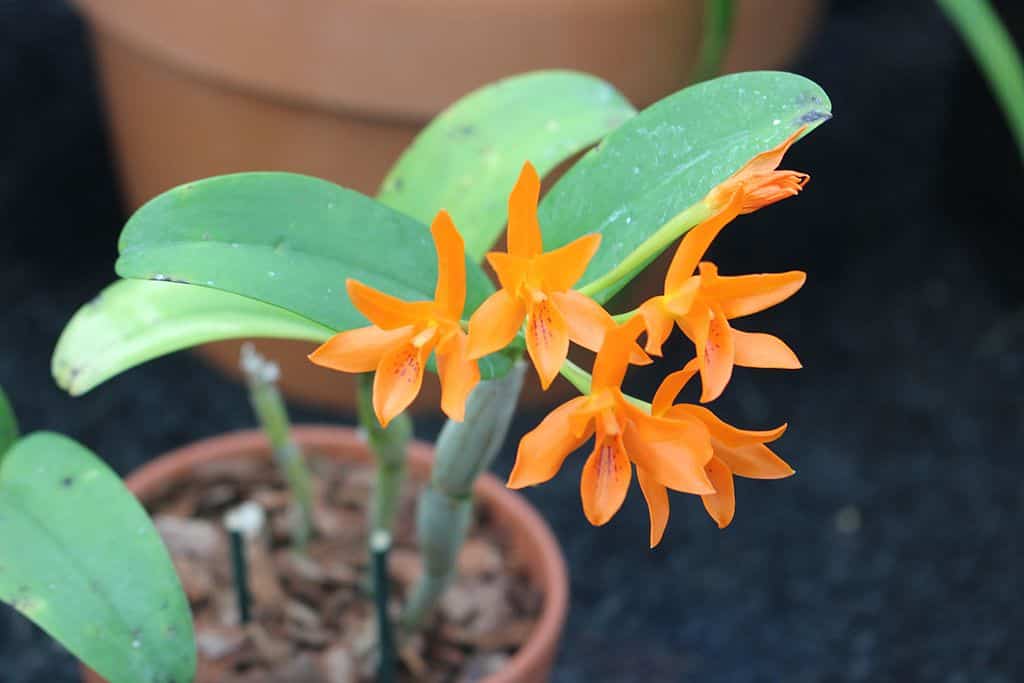If you want a whimsical, vividly-hued orchid to brighten your collection, check out these orange-flowered species. Our list comprises three stunning species from distinct native environments, so you’ll likely find a gorgeous option to fit your growing climate.
In this guide, we’ll cover orchid classification and present our three orange orchid species, their native growing ranges, morphologies, and specific growing requirements.
Orchid: Botanical Classification
Around 28,000 species make up the Orchidaceae family, which currently holds the position as the second-largest flowering plant family. It’s one of the most diverse flowering families on Earth, with species growing in the soil (terrestrial), high up in trees (epiphytic), and attached to rocks (lithophytic). Orchidaceae is especially well suited to living in the tropics, with at least 10,000 species calling this climate zone home.
Three Orange Orchid Species

While orange orchids don’t occur too commonly in nature, quite a few species from various growing environments produce outstanding orange blooms. If you are looking for cultivated orange-flowered orchids, your options increase dramatically.
To get you started on finding naturally-occurring orange-flowered orchids, we’ll discuss in depth the following three species:
- Brassia aurantiaca ‘Orange Claw’
- Guarianthe aurantiaca ‘Orange Guarianthe’
- Platanthera ciliaris ‘Orange-Fringed Bog’
Read about these plants’ native ranges, morphologies, and unique growing requirements.
1. Brassia aurantiaca ‘Orange Claw’

The ‘Orange Claw’ orchid produces vividly orange,
starfish
-shaped, 1-inch-wide blooms.
Dwelling high in the wet montane forests of Colombia, Venezuela, and Ecuador, this cool-to-cold-growing epiphytic orchid grows natively between 7,100-7,600 feet. The ‘Orange Claw’ orchid is one of 34 currently recognized species in the Brassia genus, commonly called spider orchids, for their often spindly petals and sepals. Previously, this orchid was classified as Ada aurantiaca.
Morphology
These orchids bring quite the eye-catching, whimsical addition to a garden or houseplant collection. The ‘Orange Claw’ orchid produces vividly orange, starfish-shaped, 1-inch-wide blooms. The sepals and lateral petals are notably narrow and elongated, creating the imagery of a reaching, clawed hand. The labellum (modified lower petal or lip) of Brassia aurantiaca is small and rather indistinct, producing only a small landing pad for pollinators. Since one of its major pollinators is hovering hummingbirds, a large labellum isn’t really necessary. Its bright orange blooms do, however, readily attract them.
The flowers typically bloom in late winter or early spring, producing dense clusters of semi-open blooms on arching 12-20 inch long stems. The leaves are light to mid-green, lanceolate, and erect to arching, growing in pairs up to 12 inches long.
Plant Care
A good option for beginner growers, ensuring that your orange claw orchid will thrive is relatively easy, provided you follow growing guidelines. We’ll break down what those requirements are below.
Watering
Starting in late winter, you’ll want to water this plant abundantly to facilitate growth and bloom production. Do not allow the growing medium and roots to dry out while avoiding over-saturated substrate and soggy roots. Good airflow and drainage are crucial. Ideally, avoid using hard water. You can cut back on watering during the late fall and winter, but you shouldn’t let the plant fully dry out.
Light
The orange claw orchid thrives on medium-to-bright, indirect light and should not be exposed to direct sunlight. If growing inside, avoid placing this plant in a south-facing window.
Temperature and Humidity
Thriving in the cool-to-cold mountains of its native environment, Brassia aurantiaca prefers summer temperatures at a maximum of 80 degrees Fahrenheit during the day and about 60 degrees Fahrenheit at night. During winter, exposure to temperatures down to around 45 degrees Fahrenheit is crucial to trigger growth in late winter or early spring.
Their ideal humidity level during active growth is between 70-75%. During its rest period, humidity levels between 50-70% are best.
Fertilizer and Growing Medium
Perhaps the most tedious part of caring for this orchid is its growing medium requirements. The orange claw orchid does not thrive in stale substrate, so you’ll find that refreshing the potting mixture at least once per year is crucial to this plant’s health. The ideal potting and substrate for Brassia aurantiaca is hanging, open-slotted wooden baskets shallowly filled with coarsely chopped fir or tree fern bark amended with perlite, coarse peat, and lava rock.
Fertilizer application is typical of an epiphytic orchid. Feed weakly weekly during active growth with 1/4-1/2 the dosage of water-soluble orchid fertilizer. Choose a fertilizer with a high nitrogen content from spring to mid-summer and one high in phosphorus from late summer through autumn. Reduce or eliminate feedings during dormancy until new growths appear.
2. Guarianthe aurantiaca ‘Orange Guarianthe’

The ‘Orange Guarianthe’ orchid produces shiny, 1-inch-wide orange blooms.
This small-to-medium-sized epiphytic, or occasionally lithophytic, orchid’s native range extends throughout the tropical regions of Mexico, Guatemala, Honduras, El Salvador, Nicaragua, and Costa Rica at elevations between about 900-4,800 feet. You may find the ‘Orange Guarianthe’ still referenced as the Cattelya aurantiaca ‘Orange Cattleya,’ but several species, including this orchid, split from Cattelya into the Guarianthe genus in 2003.
Morphology
This lovely tropical orchid produces shiny, 1-inch-wide orange blooms perfect for brightening a garden or indoor houseplant collection. The bright orange sepals are elliptically shaped and either completely orange or sometimes feature red stripping or mottling, and the lateral petals are much more narrow but just as vivid. The labellum is shaped like the sepals and only a touch more significant. However, it typically features unique red striping and mottling over its bright orange base, which is particularly alluring to its hummingbird pollinators.
The ‘Orange Guarianthe’ produces two leaves per pseudobulb as a bifoliate orchid. The leaves are fleshy and elliptic to lanceolate in shape and grow up to 6.5 inches long. Each pseudobulb produces a stem from late winter through spring containing between 2-11 flowers.
Plant Care
A popular choice for home growing in Central America, this orchid is fairly beginner-friendly. Generally, it requires regular tropical orchid care or especially well-draining substrate, consistent airflow to the roots, and frequent watering during its growing season. It does tend to direct a bit more light than other tropical species.
Watering
You’ll want to water this orchid enough to moisten the roots and growing substrate during active growth. In its ideal humidity range, this looks like watering twice a week with possible misting in between. Ideally, water with a source that has a neutral pH. Cut back on watering during its resting period, allowing the substrate to barely dry out before watering again.
Light
Perhaps the unique aspect of caring for the ‘Orange Guarianthe’ orchid is its bright light requirements. While most tropical epiphytic orchids prefer strictly indirect sunlight, this plant is happy with morning to midday direct sun exposure and 60% shade for the rest of the day. If this orchid does not receive enough light, its leaves will turn dark green, and you may even notice foliage or blooms dropping off.
Temperature and Humidity
The ideal active growth temperature for this orchid is intermediate-warm. So, aim for up to around 85 degrees Fahrenheit during the day and down to 60 degrees Fahrenheit at night. During its dormancy phase, temperatures should drop to around 50 degrees Fahrenheit for about four months, which will help trigger late winter or early spring growth.
Try to maintain a humidity range year-round between 50-70%.
Fertilizer and Growing Medium
This orchid doesn’t require much feeding, so only fertilize it once every 10 days to two weeks during its growing phase. Decrease this to monthly feeding with a balanced, water-soluble orchid fertilizer in the winter.
The best methods for growing this orchid are either mounted to bark or potted in hanging, open-slotted wooden baskets that ensure proper drainage and root aeration. A fantastic potting mix for this species is perlite-based with orchid moss, ground coconut shells, and lava rocks.
3. Platanthera ciliaris ‘Orange-Fringed Bog’

The ‘Orange-Fringed Bog’ orchid thrives in moist, sunny conditions.
Native to the coastal plain areas of New England and widespread throughout the southeastern U.S., the ‘Orange-Fringed Bog’ orchid thrives in moist, sunny conditions. How many species in the Plantanthera genus varies by source, but the highly regarded North American Orchid Conservation Center estimates at least 100 terrestrial species distributed across North America, Europe, and Asia.
Morphology
The flower produced is rather eye-catching with its deeply fringed labellum. The dense, fringed clusters of tiny flowers give the illusion of little exploding suns, bright and luminous against a meadow backdrop. In contrast to the spindly yellow and white labellum, the lateral petals and sepals are bright orange and softly rounded at their tips.
The long, bare flower spike on this orchid grows up to 36 inches tall and, for about a month between mid- to late-summer, produces between 30-60 blooms per stalk. The leaves are grass-like, narrow, and indistinct, emerging in a sparse, alternate pattern up the main stem.
Plant Care
This showy orchid is hard to miss and makes for an excellent, lively addition to pond or boggy garden areas. You can also readily grow this terrestrial orchid in containers. This species is becoming more difficult to find in nature in its northern range, so always source your plants from a reputable wildflower nursery.
Watering
Unlike most species in the Orchidaceae family, the ‘Orange-Fringed Bog’ orchid can tolerate some standing water. You certainly don’t want to let this water-loving orchid dry out at any time of the year. While it can tolerate standing water far better than many of its relatives, its ideal to water in a growing medium that drains well and has excellent aeration, as this orchid is still susceptible to root rot.
Light
Platanthera ciliaris can grow in full sun to bright, indirect sunlight in its natural environment. If you are going to grow this plant in full sun, remember that it naturally grows in areas with dense ground cover, which helps to protect the soil from heating up and damaging the roots. Mulching with pine needles or companion planting can help protect from sun damage.
Temperature and Humidity
This plant thrives on mild summer temperatures, so keep it from exposure to daytime temperatures above 80 degrees Fahrenheit. Nights are best around 60 degrees Fahrenheit. It is cold-hardy with proper mulching and needs cold exposure down to 35-40 degrees Fahrenheit during dormancy.
If growing in garden beds in a region with winter temperatures that dip below freezing, you can carefully dig the plant up, pack it in a plastic bag filled with appropriate growing substrate, and keep it in a refrigerator (not freezer) for about three months at temps between 35-40 degrees Fahrenheit. Replant in spring after the last frost date.
Aim for a humidity level of around 70% in summer, dropping to around 50% in the winter.
Growing Medium and Fertilizer
This orchid does excellently in loamy, acidic (5.0-6.0 pH), fertile, well-draining, and well-aerated soil. To further assist with drainage and aeration, add peat moss and perlite.
You can use a water-soluble, balanced, all-purpose orchid fertilizer at 1/4 strength for this species. You don’t need to feed as generously as other species, so stick to fertilizing about every three weeks until dormancy, when you can remove fertilizing altogether until new growth emerges.
Thank you for reading! Have some feedback for us? Contact the AZ Animals editorial team.







